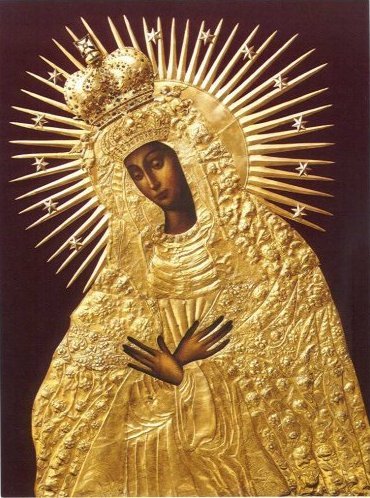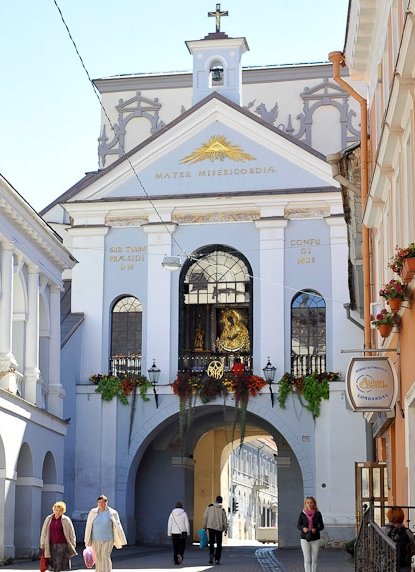Vilna
The Mother of God of Ostra Brama
Mother of Mercy
In the Ostra Brama,(Polish:. Sharp Gate) or Auros Vartai (Lithuanian: Gate of Dawn) of the old city walls of Vilnius or Vilna, capital of Lithuania. 1620-30, 163x200 cm.
The city walls of Vilna were built around 1514 and include the two story tower of the Gate of Dawn, whose upper floor holds the chapel of this miraculous image. It was customary to mount an image of Jesus, his Mother, a saint or angel on these city gates for additional protection 'from on high.' The Virgin of Ostra Brama was installed there by the Carmelite order, replacing an earlier image that had been damaged by the elements. Several Carmelite priests cared affectionately for the image and helped spread its fame. In 1627 they built a more protective chapel for it.
Good timing, because in 1655 a Russian army set fire to Vilna and the city burnt for 17 days. Yet the image of the Mother of God survived without any damage. Since then it is considered a miraculous symbol of Lithuanian and Polish independence, revered by Catholics and Orthodox alike. Between 1671 and 1761 seventeen more miracles attributed to the Lady in this image were chronicled. One story tells of a boy who fell from the second floor of a building and died. When his mother prayed before Our Lady of the Gate of Dawn he revived.
Photo by: wnieznane.pl (cropped)
In 1711 or 1715 the chapel did burn down to the ground, but not before a young monk could save the icon from the flames. For the next twenty years Our Lady resided in a church until her Sharp Gate was rebuilt with non-flammable materials. Then she was brought home to the Ostra Brama with great ceremony.
Lithuania became an independent kingdom in 1253 C.E., but in the 14th century it grew ever closer together with Poland until the two countries formed the Polish-Lithuanian Commonwealth in 1569. The two populations intermingled and so the Lithuanian Poles, who actually formed the majority of the population of Vilna, also claimed her as a symbol of Polish independence from Russians and Germans.
Whenever Vilna was in trouble, the Madonna was right in the middle of it, quite literally. In a 1794 Polish-Lithuanian uprising against the Russian occupiers the image was damaged but could be repaired. Five years later, armed conflict with Russia again flared up and threatened the chapel; this time it remained unharmed.
During the time of the partitions of Poland, in the late 18th century, the Russians, Germans, and Austrians split the Polish-Lithuanian Commonwealth up and divided it among themselves. For more than a hundred years, Lithuania ceased to exist as a separate entity and Vilnius became part of the Russian Empire. Lithuanians resisted with civil disobedience and with demonstrations inside the Sharp Gate and in the surrounding streets, the very heart and soul of the country. They crowned their Mother of God in 1927, the year after Soviets and Lithuanians signed a treaty of non-aggression.
During World War II people considered hiding the image in a safer place, but the Archbishop of Vilna decided that the dark Mother should stay with her children. She helped them pray and struggle first for deliverance from the Germans, then from the Soviets. Lithuania was the first Soviet Republic to gain its independence in a peaceful struggle that cost only few lives.



